2023 Outlook for the farm equipment market
Tuesday, November 8, 2022
Reference: FCC
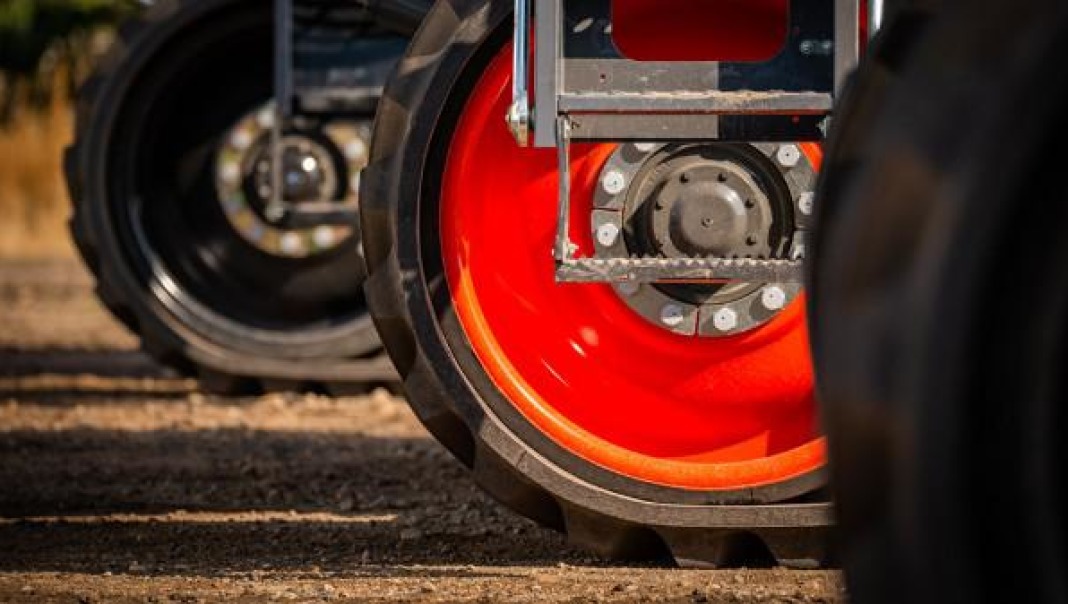 FCC Economics helps you make sense of the top economic trends and issues likely to affect your agri-business in 2023.
FCC Economics helps you make sense of the top economic trends and issues likely to affect your agri-business in 2023.Overall demand for farm equipment is projected to remain strong into 2023, despite rising interest rates and a weakening Canadian US exchange rate. Demand is supported by strong farm cash receipts, even with commodity prices softening from peak levels. As supply chains recover, equipment manufacturers are expected to increase the delivery of new equipment orders. However, inventory levels will remain below pre-pandemic levels as we project inventory levels could remain tight beyond 2024.
Sale projections
Sale trends for the remainder of 2022 are expected to be mixed. Higher horsepower tractors, combines, and implement sales are expected to have positive year-over-year growth, while lower horsepower tractor sales are expected to decline in 2022 because of slowing economic growth. Sales of smaller equipment are projected to decline as broad economic conditions worsen in Canada. A slowdown in low-horsepower tractor sales may allow manufacturers to allocate production to higher-horse-powered tractors utilized in agriculture. Further delays in equipment arrival before the end of the year could change these projections.Farm equipment sales projections for 2023 are projected higher for high horse-powered tractors, combines, and implement sales driven by strong crop receipts:
- 100+ HP tractor sales to rise 8.7%
- 4WD tractor sales to rise 13.9%
- Combine sales to rise 19.3%
- Canadian agricultural implement manufacturing to rise 32.2%
- < 40 HP tractor sales to decline 0.4%
- 40 – 100 HP tractor sales to rise 0.4%
Figure 1. Supply chains are improving but are far from pre-pandemic levels
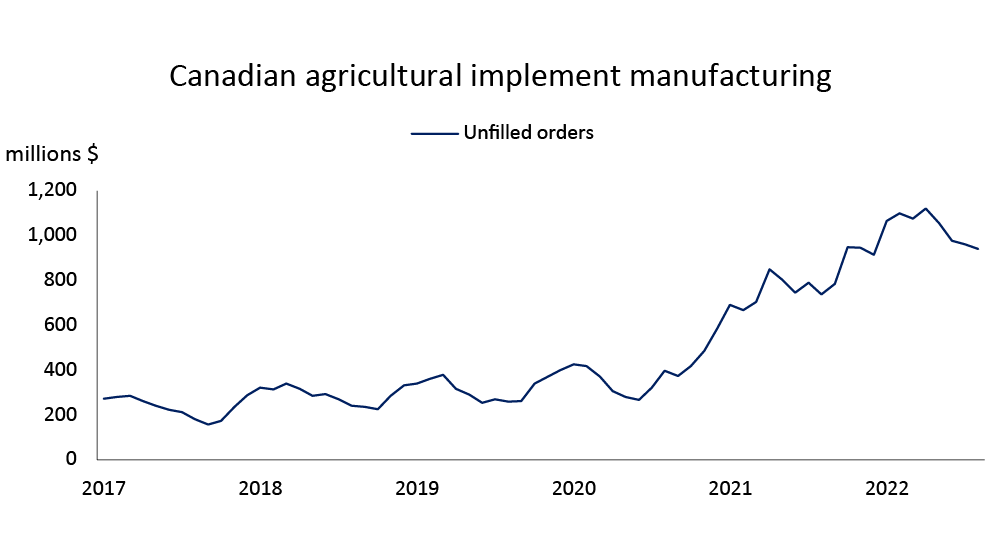
Source: Statistics Canada (NAICS 33311)
Inventory is projected to remain tight
We are anticipating inventory levels will remain tight through 2024 as producer demand remains strong for farm equipment and manufacturers catch up on pre-orders. Inventory levels of new farm equipment have trended below the five-year average (tractors are down 42% and combines down 47%). Strong demand for farm equipment for the remainder of 2022 is expected to reduce inventory levels further and support higher prices. The good news is that equipment manufacturers are expected to adjust their production upward due to the changing economic environment as North American equipment dealers begin to rebuild their inventories. We expect farm equipment dealers to remain 100% sold on new equipment. However, individual dealer revenue remains uncertain and tied to deliveries and allocations from manufacturers. Overall, dealer sale revenue will come down to the number of trades that materialize once new equipment arrives.- Combine inventory projected to remain pressured into 2024
- 4WD tractor inventory levels are projected to recover slowly
- Inventory levels are recovering for smaller horse-powered units
Figure 2: Inventory levels are recovering for smaller horse-powered units
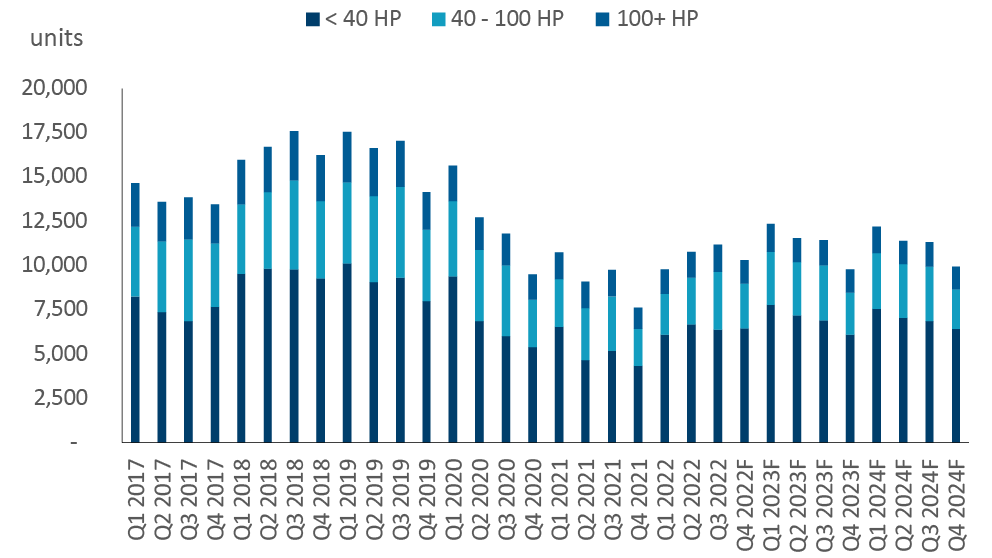
Figure 3: Combine and 4WD inventory levels projected to remain tight
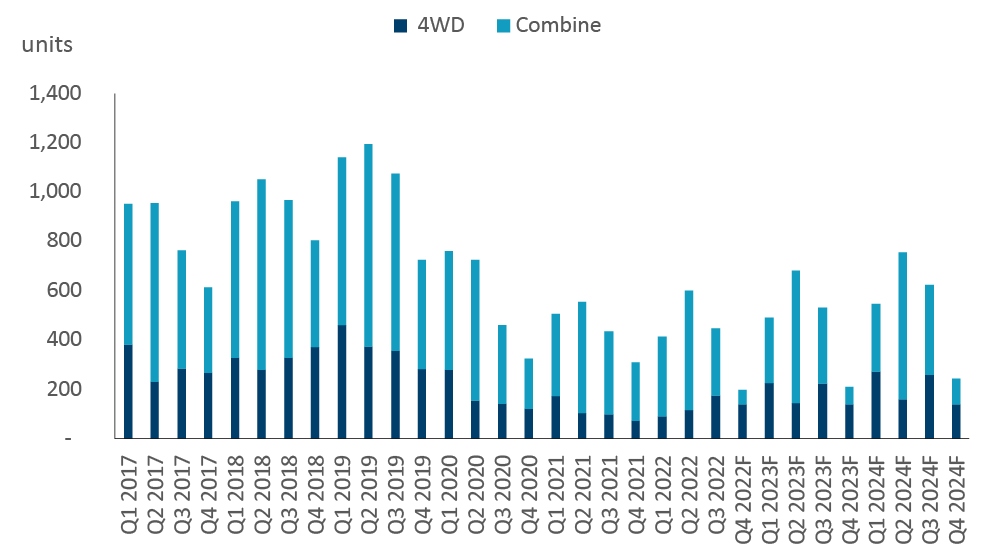
Equipment prices
Farm equipment prices are expected to be higher in 2023 due to the depreciation of the Canadian dollar and inflationary pressures in the supply chain that occurred in the last half of 2022. The Canadian dollar has a direct impact on equipment prices. Most new tractors and combines sold in Canada are manufactured south of the border, so an expected depreciation of the loonie through 2023 should lead to price increases on farm machinery (Figure 4). Domestic manufactured equipment, including air drills and seeding equipment, tillage, grain carts, swathers and other “short-line” equipment prices, are less directly connected to the Canadian dollar.Figure 4: Farm equipment prices are expected to continue trending higher
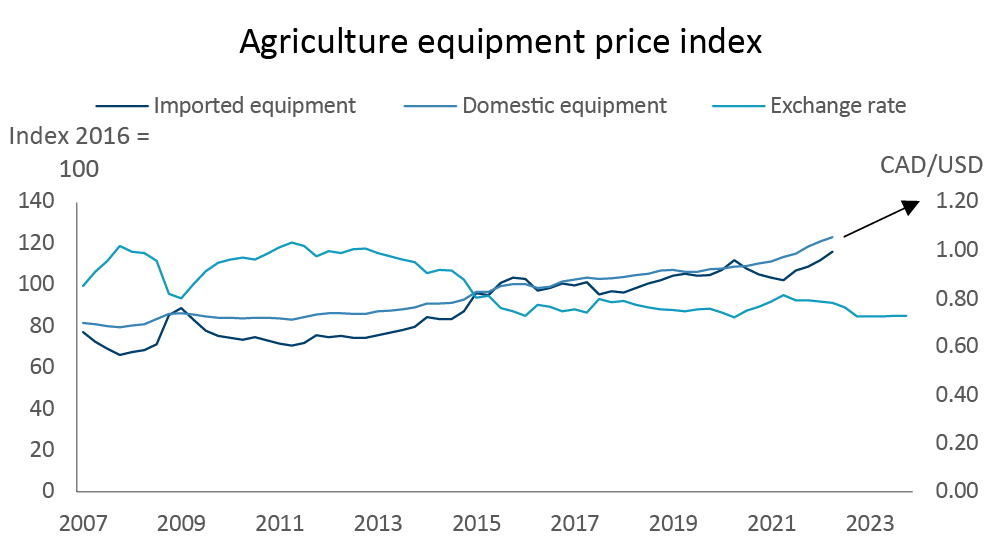
Impact on used equipment and parts market
Supply chain disruptions because of the pandemic-related shutdowns directly impacted the availability of new equipment and parts. Strategic planning on farms meant having additional used equipment available in the event parts and services were unavailable. These farms either kept their older machines or sought used equipment at auctions. Dealers also shifted strategically to servicing or overhauling used equipment to ensure customers could continue using their existing equipment for another year or longer. Inventory in the used equipment market declined as a result. This has had a profound impact on the used equipment market. Throughout 2021-2022 used equipment (e.g., 4-5-years-old) was selling for prices like what they were worth two years earlier.Two key financial trends to monitor in 2023... Read More
Sign up to stay connected
- News
- Property Alerts
- Save your favourite properties
- And more!
Joining Farm Marketer is free, easy and you can opt out at any time.
